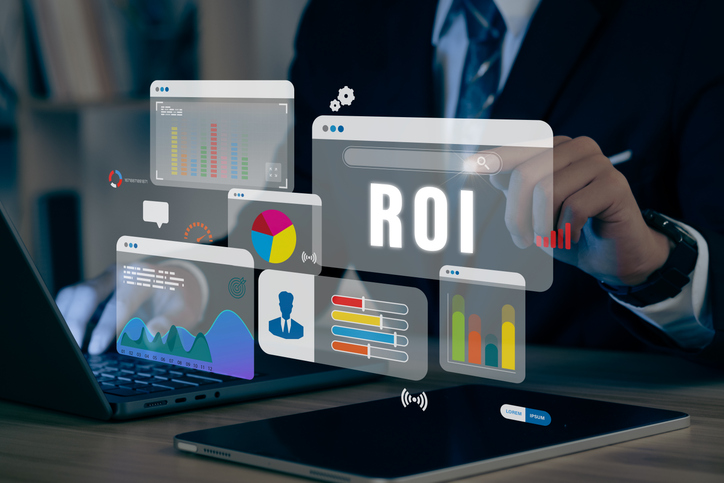How to Calculate ERP Implementation Cost
Implementing an Enterprise Resource Planning (ERP) system is a significant undertaking for any organization. One of the most critical aspects of the implementation process is understanding and accurately calculating the associated ERP cost of implementation. ERP implementation costs vary significantly depending on factors such as the size of your organization (how many users), the complexity of the implementation, and the specific needs of your business.
This guide will help you understand the factors that affect ERP software implementation costs and how to save money as you create an accurate budget for your project.

Calculating ROI for Your ERP Project
Download this eBook for ways to calculate return on your ERP investment.
ERP implementation costs are often underestimated, and the hidden costs can be significant. The visible costs, such as software licensing and consulting fees, are typically just the tip of the iceberg."
John Edwards, Computerworld
Understanding ERP Implementation Basics
Before we dive into the specifics of calculating ERP implementation costs, let’s start by understanding the basics of ERP implementation. An ERP system is a software solution that integrates and manages various operational functions, such as finance, human resources, supply chain management, project management, inventory management, manufacturing and marketing, all within a single unified database. ERP systems help your business streamline processes, increase productivity, bring increased supply chain visibility and improve decision-making.
The ERP project implementation process typically consists of several phases, including discovery and planning, design, development, testing, deployment and ongoing maintenance and support. Each phase requires careful planning, coordination and resources to ensure a successful implementation.
1. Discovery and Planning
The discovery and planning phase sets the foundation for a successful ERP implementation. During this phase, a project team is formed to assess your organization’s needs, conduct vendor evaluations and define project goals, timelines and budgets. A comprehensive project plan is developed, outlining the implementation strategy and key milestones.
2. Design
In the design phase, your project team collaborates to map out how the new ERP platform will align with your organization’s workflows and processes. This phase involves identifying any gaps between your organization’s requirements and the out-of-the-box functionality of the chosen ERP solution. Customizations and integrations are planned to address these gaps effectively.
3. Development
The development phase focuses on customizing the ERP system to meet your organization’s specific needs. Internal and external resources work together to configure the system, migrate data from legacy systems and develop any required integrations with external software. This phase also includes thorough testing to ensure the system functions as intended.
4. Testing
Testing plays a crucial role in validating the effectiveness and stability of the implemented ERP system. End-users and relevant stakeholders participate in testing activities to verify the system’s accuracy, functionality and usability. Any issues or bugs identified during testing are addressed and resolved before moving to the deployment phase.
5. Deployment
The deployment phase involves the actual rollout of the ERP system to end-users. This phase requires careful planning and coordination to ensure a smooth transition from legacy systems to the new ERP software. Data migration, employee training and change management activities are critical components of a successful deployment.
6. Maintenance and Support
Once the ERP system is deployed, ongoing maintenance and support are necessary to keep the system running smoothly. Vendors typically provide support packages to address any technical issues, provide software updates and offer assistance when needed. It is important to factor in the costs associated with ongoing maintenance and support when budgeting for ERP implementation.

Factors That Influence ERP Implementation Cost
ERP implementation cost is dependent on a number of factors, including the size and complexity of your business and a variety of additional costs. Considering these ERP cost factors is a must when estimating your ERP budget.
“Software should, according to ERP vendors, cost roughly 3% of annual revenue, with the price varying for each customer. However, this can result in erroneous numbers by ignoring crucial elements like profit margins.”
Software Connect
The following are the key factors that impact ERP implementation cost:
1. Number of Users
The number of users who will have access to your ERP solution is a significant factor in determining the overall cost. Business size can either be small, medium or enterprise according to the census bureau and SBA (Small Business Administration). Most ERP vendors charge fees based on the number of users. The more users you have, the higher the additional costs will be and vice versa.
Additionally, you need to account for the cost of adding new users in the future as your organization grows. It’s essential to work closely with your ERP vendor to understand their pricing structure and ensure that it aligns with your organization’s needs and growth plans.
2. ERP Software and Modules
The specific base ERP software and modules you choose will also impact the overall ERP implementation cost. Different vendors offer various modules and functionalities that cater to your specific business needs.
It’s important to carefully evaluate your organization’s requirements and select the modules that align with your goals. Some common ERP modules include accounting/financial management, human resources management, inventory management, customer relationship management (CRM) and supply chain management. Each module may have its own associated costs, so it’s crucial to consider these expenses when budgeting for your ERP implementation.
3. ERP Software Customization and Integration
Customizations and integrations are often required to tailor the ERP system to meet your organization’s specific needs. Customizations involve modifying the ERP software to align with your unique business processes and workflows. Integrations, on the other hand, involve connecting the ERP system with other critical business systems, such as your industry-specific software or external databases.
Customizations and integrations add significant costs to your ERP implementation budget, so it’s important to carefully assess the full extent of your organization’s customization and integration requirements.
4. ERP Implementation Strategy
An ERP implementation strategy is a plan that outlines the steps and best practices for deploying your new ERP software. The implementation strategy that you choose has an impact on your ERP implementation cost.
The most popular implementation strategies used by organizations include:
Big bang: This ERP software implementation strategy involves implementing the new ERP system all at once. It is the quickest way to implement a new ERP system. However, this strategy is the one that has the most risk involved.
Phased rollout: This ERP software implementation strategy involves implementing the new ERP system in phases, one module or department at a time. This approach is less risky than the big bang approach, but it can take longer to implement the new system.
Pilot rollout: This ERP software implementation strategy involves implementing the new ERP system for a pilot group of users before rolling it out to the entire organization. This approach can be used to test the new system and identify any potential problems before they impact the entire organization.
The factors that affect the choice of an implementation strategy include the complexity of your business processes, the availability of resources and the level of disruption your organization can tolerate during the implementation process. It’s important to consider the potential costs associated with each implementation strategy when planning your budget.
Ready to start your digital transformation journey?
Click the button below to request your free discovery call.

5. Deployment Method
The deployment method you choose for your ERP system can have a significant impact on costs. There are typically three deployment options: on-premises, cloud-based and hybrid.
Cloud Based ERP Solution: Cloud ERP software is hosted and managed by your ERP vendor. Your organization accesses cloud solutions via a web browser, and does not need to install or maintain any software on your own servers.
On-premises ERP solution: An on-premise ERP solution of an ERP platform is when the software is installed and managed by your organization on your own servers.
Hybrid ERP: Hybrid ERP systems combine elements of both cloud ERP and on-premise ERP.
Cloud-based ERP solutions often have lower upfront costs since you don’t need to invest in further infrastructure upgrades. However, cloud-based solutions typically have ongoing subscription costs that need to be considered when budgeting for your ERP implementation, unlike an on-premise deployment.
6. Training and Change Management
Training and change management are critical components of a successful ERP implementation. It’s important to invest in comprehensive training programs to ensure that your employees can effectively use the new ERP system.
Training costs include expenses such as training materials, instructor fees and employee time dedicated to training sessions. Change management activities, such as communication, stakeholder engagement and addressing resistance to change, should also be factored into your budget.
A well-executed training and change management program can help maximize the benefits of your ERP system and minimize disruptions during the implementation process.
7. Maintenance and Support
ERP systems require ongoing software maintenance costs and support to ensure their smooth operation. It’s important to consider the ongoing ERP costs associated with software updates, bug fixes and technical support when budgeting for your ERP implementation.
Some vendors offer maintenance and support packages as part of their subscription fees, while others may charge additional fees for these services. Understanding the level of support you will require and the associated recurring costs is crucial for accurately estimating your ERP implementation budget.
8. Hidden ERP Implementation Costs
In addition to the factors mentioned above, there may be hidden costs associated with your ERP implementation. These costs include expenses such as data migration, additional hardware or software requirements, security measures and add-on modules or functionalities.
It’s important to conduct a thorough analysis of your organization’s specific needs and requirements to identify any potential hidden costs of your ideal ERP solution. By accounting for these costs upfront, you ensure that your budget accurately reflects the total cost of your ERP implementation.
What is ERP Total Cost of Ownership (TCO)?*
- Cost of ERP for Small Businesses
ERP costs for small businesses earning about $1 million in annual revenue range between $1,740 and $4,620 per month. In terms of annual cost, the ERP solutions may cost between $20,880 to $55,440. However, this amount does not take into account the initial implementation or user training. Because the number of users in small businesses is between 50 to 150 employees, the per user ERP cost can vary greatly. - Cost of ERP for Midsize Businesses
Enterprise Resource Planning costs for midsize businesses earning between $50-$100 million per year ranges between $4,620 and $5,160 per month for an ERP solution. The higher the number of users, the higher the cost of ownership of the ERP software. - Cost of ERP for Enterprises
The average monthly expense for an ERP system is $9,330 for an enterprise-level business with at least 1,000 employees and yearly revenue of over $100 million. However, on a per user basis, ERP costs for enterprises may be lower compared to small and midsize businesses because of the bulk discounts that may have been applied.

Pricing Models for ERP Implementation
ERP vendors typically offer different pricing models to accommodate varying customer needs. The three primary ERP pricing models are perpetual licensing, subscription-based pricing and usage-based (per user) pricing:
1. Perpetual Licensing
A perpetual license involves a one-time upfront fee to purchase the ERP software licenses. The perpetual license model allows your company to own the software indefinitely and provides more control over the system.
However, perpetual licensing often requires additional investments in maintenance, support and upgrades. It is important to consider the long-term total ERP cost associated with perpetual licensing when evaluating this pricing model.
2. Subscription-Based Pricing
Subscription-based pricing offers a pay-as-you-go ERP cost model, where your organization pays a recurring fee, typically on a monthly or annual basis, to access the ERP system. This model often includes maintenance, support, and upgrades as part of the subscription package. Subscription-based pricing provides lower upfront costs and greater flexibility, making it a popular choice for many organizations.
3. Usage-Based Pricing
Usage-based pricing or per user pricing is a pricing model where your organization is charged based on how much you use the ERP system. This model is often used for cloud-based ERP systems, as it allows you to scale your usage up or down as needed.
If your organization has fluctuating demand, then per-user-based pricing can be a good option as it allows you to pay only for what you use. However, it is important to carefully consider your usage patterns when choosing this model, as a per-user model can be more expensive than other models if you have high usage levels.

Creating an Accurate ERP Implementation Budget
Now that we have explored the key factors that influence the costs of implementing ERP systems, let’s discuss how to create an accurate budget for your ERP project. The following steps will guide you through the budgeting process:
Step 1: Define Your Project Scope
Start by defining the scope of your ERP implementation project. Clearly identify your organization’s goals, objectives and specific requirements. Determine which ERP modules (CRM module, supply chain module, etc ) and functionalities are essential for your business processes.
Consider the following factors:
- The number of users who will access the system
- The level of customization required
- Any integrations with external systems
Step 2: Conduct a Needs Assessment
Conduct a comprehensive needs assessment to understand your organization’s specific requirements and challenges. Engage with key stakeholders and department heads to gather valuable insights and input. Identify pain points, bottlenecks and areas for improvement within your current business processes.
This assessment will help you determine the scope and scale of your ERP implementation and provide a foundation for estimating your ERP software cost.
Step 3: Research ERP Vendors and Pricing Models
Research different ERP vendors and their pricing models to understand the options available to you. When researching ERP vendors, consider the following factors:
- The reputation of the vendor
- The functionality of their ERP system
- The level of customer support they offer
Compare pricing models, including subscription-based models and perpetual licensing, to determine which option aligns best with your budget and long-term needs.
Step 4: Estimate Implementation Costs
Based on the scope of your project, your needs assessment and chosen ERP solution provider, estimate the ERP implementation costs. Consider the following factors when estimating the implementation cost:
- Software licensing fees
- Customization costs
- Customized ERP training expenses
- Any additional hardware or software requirements
Consult with your chosen ERP vendor to obtain accurate pricing information and budget internal resources accordingly.

Step 5: Account for Ongoing Costs
Don’t forget to account for ongoing costs associated with your ERP system. These costs include the following:
- Subscription fees
- Maintenance and support costs
- Potential future upgrades or add-on modules
It’s important to consider the long-term financial impact of your ERP implementation and ensure that your organization can sustain these expenses.
Step 6: Identify Risks and Contingency Plans
Identify potential risks and challenges that may impact your ERP implementation budget. Evaluate the likelihood of these risks and estimate the potential costs associated with them. Develop contingency plans to mitigate these risks and ensure that your budget will remain on track even in the face of unexpected challenges.
Step 7: Regularly Review and Adjust Your Budget
Throughout the ERP implementation process, regularly review and adjust your budget as needed. Monitor actual ERP installation costs against your budgeted amounts, and make adjustments as necessary. Regularly communicate with your project team, stakeholders and ERP vendor to ensure that everyone is aware of the budgetary constraints and can make informed decisions.
By following these steps and conducting thorough research and analysis, you can create an accurate ERP implementation budget that aligns with your organization’s needs and resources.
Conclusion
Implementing Enterprise Resource Planning software is a significant undertaking that requires careful planning, budgeting and consideration of various factors. Understanding the key factors influencing ERP implementation costs, evaluating pricing models and accounting for hidden costs are essential steps in building an accurate ERP budget. By taking a strategic and comprehensive approach to budgeting, your organization can ensure a successful and cost-effective ERP implementation that aligns with business goals and requirements.
Remember, every organization’s ERP implementation will have unique cost considerations. It is crucial to conduct thorough research, consult with your ERP implementation partner and tailor your budget to your specific needs and circumstances. With careful planning and budgeting, you can set your organization on the path to success with your ERP implementation and reap the benefits of streamlined operations, enhanced productivity and improved decision-making.
Ultra Consultants is an independent enterprise software consulting firm serving the manufacturing and distribution industries in North America and around the world. We leverage our exceptional expertise in ERP implementations, as we bring deep industry experience, today’s best practices and a rigorous, proven methodology, to help your organization realize the benefits of modern enterprise technologies—and see real bottom-line results.
*TCO ranges are approximations. Your total costs may vary.
Table of Contents
More ERP material...
AI in Food and Beverage Manufacturing
Discover how AI is revolutionizing food and beverage manufacturing, enhancing quality, reducing…
How ERP for Quality Control Eliminates Manual Documentation Chaos
This post will examine why managing quality records outside of an ERP…
Assessing Your AI Maturity
This article breaks down how businesses can measure their AI maturity to…



